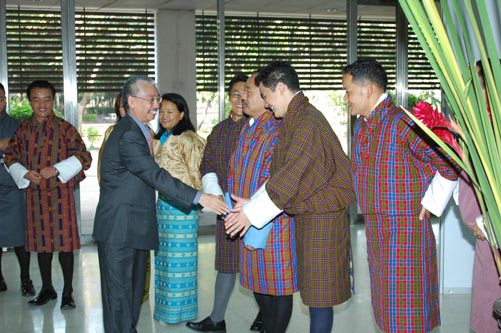
H.E. Mr. Arno Riedel (left), Austrian Ambassador to Thailand, H.E. Mr. Singye Dorjee (center), Ambassador of Bhutan, with Prof. Khin Ni Ni Thein (right), AIT vice president for development and resources are viewing the photo exhibition.
Ambassadors of Austria, Bhutan views photo exhibition at AIT
On 9 November 2006, H.E. Mr. Arno Riedel, ambassador of Austria to Thailand, accompanied by Mrs. Ulrike Nguyen, counsellor, the Austrian Embassy and H.E. Mr. Singye Dorjee, ambassador Bhutan, visited a Bhutan photo exhibition at AIT. 'Land of the Thunder Dragon' includes scenic photographs from the Kingdom of Bhutan by Austrian photographer Mr. Josef Polleross.

H.E. Mr. Arno Riedel (left), Austrian Ambassador to Thailand, talks with Prof. Khin Ni Ni Thein, AIT vice president for development and resources. Mrs. Ulrike Nguyen (second from right), counselor, the Austrian Embassy, also discusses with them.
Prof. Khin Ni Ni Thein, AIT vice president for development and resources, welcomed the two ambassadors. Joining her were AIT staff members and Bhutanese students, who said the photos reminded them of their homeland. Currently, there are more than 20 Bhutanese students studying at AIT. Some of them are financially supported by Austria.

AIT students from Bhutan welcome H.E. Mr. Singye Dorjee, Ambassador of Bhutan.
In cooperation with the Austrian and the Royal Bhutanese embassies, the photo exhibition took place at AIT Conference Center from 1-13 November 2006.

Mr. Josef Polleross (left), the Austrian photographer, briefs about his photo to H.E. Mr. Singye Dorjee (center), Ambassador of Bhutan, and H.E. Mr. Arno Riedel (right), Austrian Ambassador to Thailand.
The exhibition shows photos taken during two visits to Bhutan in November 2005 and May 2006. According to Mr. Polleross, Bhutan is undergoing a lot of changes at the moment: King Jigme Sigye Wangchuck is stepping down in 2008 and his son, Crown Prince Dasho Jigme Khesar Namgyal Wangchuck, will take his place. The absolute monarchy will be turned into constitutional monarchy with a parliamentary system the same year.
The kingdom has been opening up to larger numbers of tourists. Tourism is still quite restricted and geared towards high-end visitors to protect the unique culture of the country. This is the opposite concept of mass tourism.
Mr. Polleross said the fascination of Bhutan has several aspects: A strong Buddhist tradition with its influence on most aspects of daily life, the beauty of its largely untouched landscape with fortress-like monasteries, and above all the collective effort to protect both nature and religion from the destructive influence of market-driven economies. Gross National Happiness, a concept developed by the king, tries to achieve economic development while maintaining Bhutanese cultural and spiritual values.
Mr. Polleross' second visit was connected with the aim of the Bhutanese government to present this philosophy of the country to the outside world. He was hired to photograph different aspects of Bhutanese life and culture for an official government brochure and magazine. At the moment traditional culture for which Bhutan cares greatly and does everything to protect it and modern influence coexist without friction. Mr. Polleross was intrigued by this contrast especially seen in the dress code, and he tried to capture this wherever he came upon it. He hopes the exhibition will give the audience a glimpse of the kingdom considered by some as Shangri-La the Eden-like society created by author James Hilton in his novel, 'Lost Horizon.'
